|
Waste Statistics 2003 5 Individual waste sources and status in relation to targets for 20085.1 Waste generated by households 5.1 Waste generated by householdsWaste from households covers the waste types domestic waste, bulky waste, and garden waste, which in turn are divided into individual fractions, e.g. paper and cardboard, bottles and glass, and food waste/other organic waste. Table 20 shows waste arisings by mixed and separately collected fractions to the extent it has been possible to register these individually. This means, for example, that the amount of paper and cardboard stated does not show the complete potential in household waste arisings but only the amount which has been separated and collected for recycling. The rest of the paper is part of the fraction various combustible. Waste arisings in households in 2003 amounted to around 3,000,000 tonnes, which constitutes a 4 percentage point drop from 2002. The reduction in total household waste arisings is therefore to be found mainly in bottles and glass separated for recycling, which have fallen by 31 per cent. The fraction various combustible, however, still makes up the largest part of total household waste arisings, namely around 63 per cent. Table 20 shows several shifts between the different household waste fractions, so that paper and cardboard separated for recycling, food waste/other organic waste, hazardous waste, and ferrous metals have increased by 8 per cent, 2 per cent, 48 per cent, and 4 per cent respectively, whereas various combustible, various non-combustible, bottles and glass, garden waste, and other waste have decreased by 3 per cent, 7 per cent, 31 per cent, 4 per cent, and 8 per cent respectively compared to 2002. 5.1.1 Household waste per capita and per householdIn Table 21, household waste arisings are stated per capita and per household. Furthermore, the Table shows total arisings analysed between selected waste types and separately collected waste fractions. Total household waste generation per capita amounted to 559 kg in 2003, which is 22 kg less than in 2002. Household waste per household was 1,220 kg in 2003. Of these, domestic waste per capita and per household was 312 kg and 680 kg respectively in 2003. Compared to 2002, this means a slight fall of 5 kg per capita, while the amount per household fell by 12 kg. 5.1.2 Domestic wasteDomestic waste from households covers ordinary waste from private household consumption. This includes paper, bottles, glass, organic food waste and other waste. Usually, domestic waste is collected from households at regular intervals, once a week or once every other week. As mentioned in Chapter 1, domestic waste amounted to 1,677,000 tonnes in 2003, which is 23,000 tonnes less than in 2002. Since 1994, the amount of domestic waste has varied slightly from year to year, however, without showing any clear trend. The amount has increased by 1 per cent over the entire period, cf. Table 3. In 2003, 16 per cent of domestic waste was recycled, whereas 83 per cent was incinerated and 1 per cent landfilled. The breakdown by treatment option therefore shows slight changes from 2002 when 82 per cent was incinerated and 2 per cent landfilled. For the early years, packaging waste is included as part of the waste type domestic waste. To make comparison with these early years possible, packaging waste from households in 2001, 2002, and 2003 of 107,000, 117,000, and 85,000 tonnes respectively has been included in Figure 7. 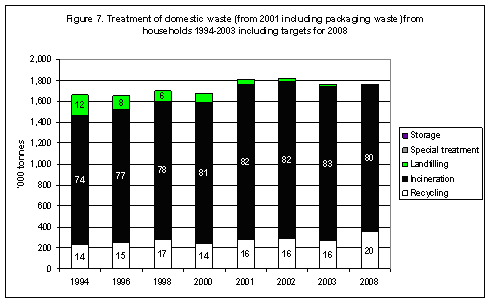
Source: same as Tables 1 and 2. Note that arisings in 2008 have been set to correspond to arisings in 2003. The figures are not projections of developments in waste arisings. As the table shows, the relative distribution in the period 1994 to 2003 among treatment options has varied only little. Considering the whole period, the trend since 1994 has shown that around 80 per cent of domestic waste is incinerated, whereas about 15 per cent is recycled and about 5 per cent is landfilled. This means that we are still incinerating and landfilling too much domestic waste compared to the targets in Waste Strategy 2005-2008 It should be noted that domestic waste is considered suitable for incineration and it is therefore not to be landfilled. If not recycled, domestic waste is to be incinerated. However, islands that are not connected by land to an incineration plant are exempt from this obligation. 
Source: same as Tables 1 and 2. Note that arisings in 2008 have been set to correspond to arisings in 2003. The figures are not projections of developments in waste arisings. 5.1.3 Bulky wasteBulky waste generated by Danish households amounted to 634,000 tonnes in 2003. This is 21,000 tonnes less than in 2002. In other words, there has been a fall of 3 per cent. During the period from 1994 to 2003 bulky waste increased by 5 per cent. Since 2000, the amount of bulky waste has shown a downward trend, cf. Table 3. The increase in bulky waste amounts is partly due to a real increase, but also to a significant extent to the establishment of waste-collection and waste-delivery schemes for bulky waste. Figure 8 shows bulky waste analysed between three treatment options: landfilling, incineration, and recycling for the period 1994 to 2003. The period 2000 to 2003 shows an almost unchanged distribution between treatment options: incineration around 49 per cent, landfilling around 27 per cent, recycling around 17 per cent, and, finally, 7 per cent in storage. 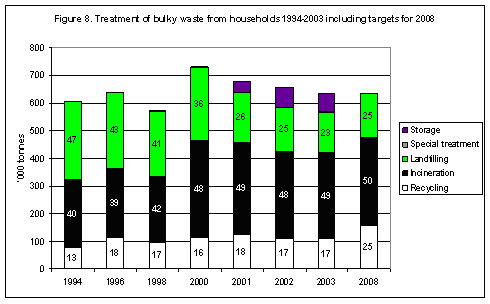
Source: same as Tables 1 and 2. Note that arisings in 2008 have been set to correspond to arisings in 2003. The figures are not projections of developments in waste arisings. In 2003, 49 per cent of bulky waste was incinerated, the rate for landfilling fell to 23 per cent, and the rate for recycling is 17 per cent. The remaining 11 per cent has been placed in temporary storage until incineration capacity becomes available [19]. This means that the real incineration rate for bulky waste is higher than 49 per cent. At the same time, the figures show that the amount of waste led to landfill has gone down considerably since 1994. The target of a maximum landfilling rate of 25 per cent has thus been met. However, too much bulky waste is still being incinerated and not enough is being recycled. If targets for treatment in 2008 are to be met, considerable efforts are required to separate and collect more of the different waste fractions in bulky waste. A number of initiatives covering e.g. cardboard, waste electronic and electrical equipment, impregnated wood and PVC-containing waste have or are in the process of being implemented. 
Source: same as Tables 1 and 2. Note that arisings in 2008 have been set to correspond to arisings in 2003. The figures are not projections of developments in waste arisings. Storage means that the waste in question has been assigned to temporary storage by local authorities (the local council), cf. section 37(3) of the Statutory Order on Waste. Denmark has excess incineration capacity, but storage can be due to e.g. repairs or shut down of operations at plants. 5.1.4 Garden wasteGarden waste collected from households in 2003 amounted to 500,000 tonnes, which is 17,000 tonnes less than in 2002, corresponding to a fall of 3 per cent. Throughout the 1990s the amount of garden waste increased steadily. From 1994 to 2003 the amount went up 74 per cent. This increase does not reflect a real increase in garden waste. It is rather the result of increasing opportunities for householders to dispose of garden waste at municipal waste treatment plants at the expense of home-composting. This means larger waste volumes to be treated in the municipal waste treatment system. Treatment of garden waste is presented in Figure 9. In 2001, 99 per cent of garden waste was recycled, and 1 per cent was landfilled. 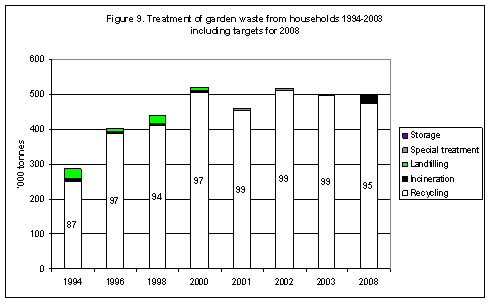
Source: same as Tables 1 and 2. Note that arisings in 2008 have been set to correspond to arisings in 2003. The figures are not projections of developments in waste arisings. 
Source: same as Tables 1 and 2. Note that arisings in 2008 have been set to correspond to arisings in 2003. The figures are not projections of developments in waste arisings. So, the targets for recycling and incineration of garden waste from households have been met by a good margin. Estimates indicate that it is impossible to increase the recycling rate any further. Future efforts with respect to garden waste will therefore concentrate on retaining the present high recycling rate and reducing the volumes treated in the municipal waste treatment system. Garden waste may be home-composted without permission from the local council, providing the regulation is complied with. Waste incineration is only allowed in plants that have been approved for the purpose. 5.2 Waste from the service sectorWaste from the service sector [20] amounted to 1,655,000 tonnes in 2003, which is 298,000 tonnes, or 22 per cent, more than in 2002. As mentioned in Chapter 1, there is however uncertainty as to the increase and it should therefore be regarded with some caution. 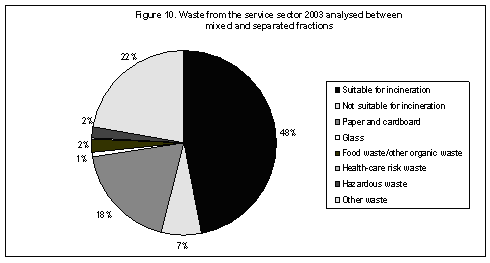
Source: ISAG reports 2003. The key is listed clockwise beginning at “12 o'clock”. Waste from the service sector analysed by mixed and separated fractions is shown in Figure 10. The amount of waste suitable for incineration fell from 55 per cent in 2002 to 48 per cent in 2003, and other waste increased from 13 per cent in 2002 to 22 per cent in 2003. Otherwise, there has not been any great changes. Waste suitable for incineration, paper and cardboard, and other waste are the three largest waste fractions from the service sector with 48 per cent, 18 per cent, and 22 per cent respectively. The increase in the amount of waste from the service sector in 2003 is apparent in the fractions: waste suitable for incineration, waste not suitable for incineration, paper and cardboard, glass, hazardous waste, and other waste. These fractions increased by 5 per cent, 7 per cent, 22 per cent, 47 per cent, and 106 per cent respectively compared to 2002. The fractions: food waste/other organic waste and healthcare risk waste show drops of 7 per cent and 11 per cent respectively. 
Source: same as Tables 1 and 2. Note that arisings in 2008 have been set to correspond to arisings in 2003. The figures are not projections of developments in waste arisings. Storage means that the waste in question has been assigned to temporary storage by local authorities (the local council), cf. section 37(3) of the Statutory Order on Waste. Denmark has excess incineration capacity, but storage can be due to e.g. repairs or shut down of operations at installations. Of the 1,655,000 tonnes of waste which the service sector generated in 2003, 44 per cent was recycled, 46 per cent was incinerated, whereas 8 per cent was landfilled and 1 per cent placed in temporary storage, cf. Figure 11. This means that more waste was recycled and less incinerated and landfilled compared to 2002. The waste put in temporary storage will be incinerated when incineration capacity becomes available [21]. In other words, the incineration rate is actually higher than the 46 per cent. This means there has been a diversion of waste volumes from landfilling, incineration and temporary storage to recycling. 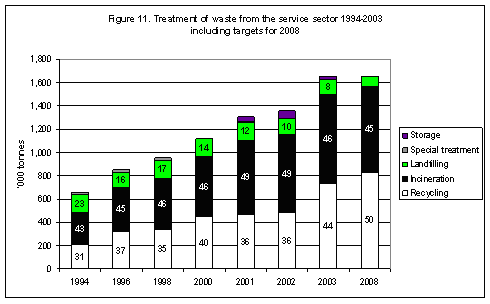
Source: same as Tables 1 and 2. Note that arisings in 2008 have been set to correspond to arisings in 2003. The figures are not projections of developments in waste arisings. As stressed in Chapter 1, the increase in waste arisings from the service sector from 2001 should be regarded with some caution. Compared to the targets for treatment in 2008 in Waste Strategy 2005-2008, Denmark is still recycling too little, and incinerating and landfilling too much waste from the service sector. If the 2008 targets are to be met, separation and collection of waste must be improved so that a larger proportion of recyclable materials can be recycled, and so that environmentally harmful waste types can be separated and treated separately. 5.3 Waste from industryWaste generation from industry amounted to 1,841,000 tonnes in 2003, which is 470,000 tonnes or 20 per cent less than in 2002. As mentioned in Chapter 1, there is however uncertainty as to the increase and it should therefore be regarded with some caution. 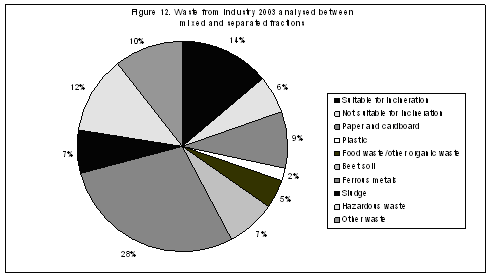
Source: ISAG reports 2003. The key is listed clockwise beginning at “12 o'clock”. Figure 12 shows a breakdown of waste from industry by mixed and separated fractions It is seen that ferrous metals is by far the largest single fraction, followed by the mixed fraction waste suitable for incineration, hazardous waste and other waste. The individual fractions' percentage share of total industrial waste have changed since 2002. The greatest changes are in ferrous metals which fell from 34 per cent in 2002 to 28 per cent in 2003, and in hazardous waste which increased from 7 per cent in 2002 to 12 per cent in 2003. The remaining fractions show changes within 4 percentage points. However, as mentioned above there has been a fall in total industrial waste arisings of around 470,000 tonnes. This fall is primarily due to reductions in the fractions: waste suitable for incineration, waste not suitable for incineration, paper and cardboard, beet soil, ferrous metals, and sludge. These fractions fell by 26 per cent, 27 per cent, 39 per cent, 48 per cent, 31 per cent, and 10 per cent respectively. By contrast, the fractions food waste/other organic waste, plastic, hazardous waste, and other waste have gone up 15 per cent, 1 per cent, 44 per cent, and 16 per cent respectively. In 2002, industry experienced a fall in waste arisings of 12 per cent from 2001; while the service sector saw a 4 per cent rise in waste generation. The shift between the two sectors may be due to incorrect reporting, as the source manufacturing etc. was discontinued from 2001 as a result of amendments to the Statutory Order on Waste [22]. This means that waste from industry must be registered as originating from one of the following 11 subgroups: food, beverages and tobacco; textiles, clothing and leather goods; wood-working and furniture; paper and graphical production; chemicals etc.; rubber and plastic; stone-working, pottery and glass; ferrous metals; other manufacturing; utilities; agriculture, forestry, fishery etc. It is likely that some carriers find it easier to register industrial waste as service-sector waste. Parties reporting to the ISAG are therefore encouraged to be aware of this possible source of incorrect reporting. Another explanation for the shift between the two sectors may be in structural changes, the fact that society is changing from an industrial to a knowledge society. The shift is supported e.g. by the fact that the number of new companies in traditional industry went down during the 1990s while the number of new companies in the knowledge services industry doubled. [23] Treatment of waste from industry is shown in Figure 13. In 2003, 63 per cent of the waste from this sector was recycled. This corresponds to 1,157,000 tonnes in absolute figures. In recent years, the recycling rate has been around 63 per cent. 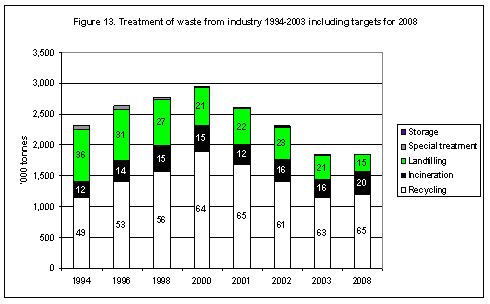
Source: same as Tables 1 and 2. Note that arisings in 2008 have been set to correspond to arisings in 2003. The figure is not intended as a projection of developments in waste arisings. 
Source: same as Tables 1 and 2. Note that arisings in 2008 have been set to correspond to arisings in 2003. The figures are not projections of developments in waste arisings. Storage means that the waste in question has been assigned to temporary storage by local authorities (the local council), cf. section 37(3) of the Statutory Order on Waste. Denmark has excess incineration capacity, but storage can be due to e.g. repairs or shut down of operations at installations. The incineration rate for industrial waste reached 16 per cent in 2003, which is the same figure as in 2002. The landfilling rate has gone down by 2 per cent. This means that the 2008 target of landfilling a maximum of 15 per cent of industrial waste has not been met. Denmark still landfills far too much industrial waste. Even if the rates of recycling and landfilling have taken a positive direction since 1994, there is still some way to go before the 2008 targets for these two treatment options have been met. The volumes and composition of waste from industry depend on the sector generating the waste, as well as size and number of enterprises. Possibilities of waste prevention or recycling will therefore differ from one waste fraction and sector to another. In order to meet the targets in the Waste Strategy 2005-2008, the Danish EPA has selected a number of waste types from industry to come into focus. These waste types include waste from foundries and shredder waste, which are to be diverted from landfilling to recycling whenever environmentally and economically efficient. With the latest amendment to the Statutory Order on Waste the Danish EPA has implemented a number of changes to the ISAG system, so that since 2001 it has been possible to analyse waste from industry between eleven different sectors. In future a number of enterprises [24]must in addition keep a register in a specific format with various information on their waste generation. This will enhance the possibility of conducting sector-specific analyses and initiatives in industry. 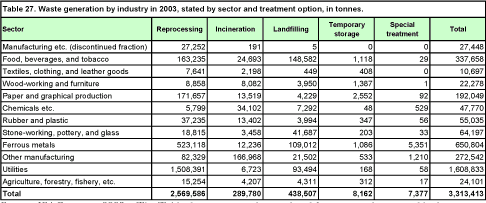
Source: ISAG reports 2003. The Table does not cover beet soil and ferrous metals reported by large scrap dealers. Waste generation in industry stated by sector and treatment option can be seen in Table 27. As apparent from the table, food, beverages, and tobacco; the ferrous metals industry; other manufacturing; and suppliers contributed 87 per cent of waste from industry in 2003. At the same time it is seen that the amount of waste from manufacturing etc. constitutes 27.448 tonnes. In 2002, waste generation from this sector amounted to 238,815 tonnes, which means that reporting enterprises have improved their reporting on the new commercial sources (cf. as the commercial source manufacturing industries etc. was discontinued in 2001). 5.4 Waste from building and construction activitiesGeneration of waste in the building and construction sector was smaller in 2003 than in 2002. Construction and demolition waste reached 3,785,000 tonnes, which is 259,000 tonnes, or 6 per cent, less than in 2002. The fall is apparent in the fractions: not suitable for incineration, concrete, tiles, soil and stone, and other recyclable waste. These fractions fell by 24 per cent, 0.1 per cent, 13 per cent, 36 per cent, and 6 per cent respectively. The fractions other construction/demolition waste, asphalt, and other waste increased by 30 per cent, 28 per cent, and 19 per cent respectively. In 2003, 476,278 fewer tonnes of soil and stone were reported. This is explained e.g. by the fact that the large operators in this area reported a significant decline in the market in the first half of 2003, leading to less waste from this fraction being received as opposed to in 2002. The second half year was reported as normal. By far the major part, or 93 per cent, of waste generated by the building and construction sector is recycled. The breakdown by treatment option in 2003 shows that the recycling rate increased by 1 per cent compared with 2002, whereas the landfilling rate went down by 2 per cent. The incineration rate was 2 per cent, cf. Figure 14. 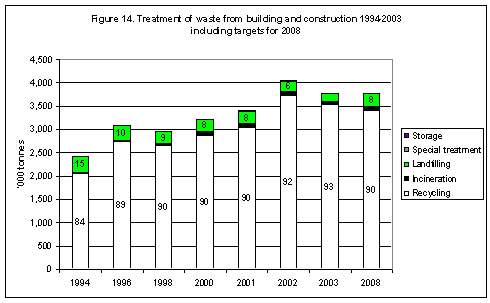
Source: See Tables 1 and 2. Note that arisings in 2008 have been set to correspond to arisings in 2003. The figures are not projections of developments in waste arisings. As the figure shows, the recycling rate for construction and demolition waste increased by 9 percentage points in the period 1994 to 2003. At the same time the landfilling rate dropped 11 percentage points. The figure also shows that the distribution of waste between the different treatment options has been in line with targets for 2008 since 2000. 
Source: same as Tables 1 and 2. Note that arisings in 2008 have been set to correspond to arisings in 2002. The figures are not projections of developments in waste arisings. The high recycling rate for construction and demolition waste is due partly to the fact that recycled waste, unlike landfilled or incinerated waste, is exempt from taxation, and partly due to a departmental circular on municipal regulation concerning the separation of construction and demolition waste intended for recycling [25]. In addition, the Danish Ministry of Environment and Energy (now Ministry of the Environment) and the Danish Contractors' Association entered an agreement on selective demolition of buildings so that waste is sorted at an early stage. Figure 15 shows construction and demolition waste analysed between mixed and separately collected fractions in 2003. It is seen that the major part of separated building waste consists of concrete, asphalt, soil and stone. 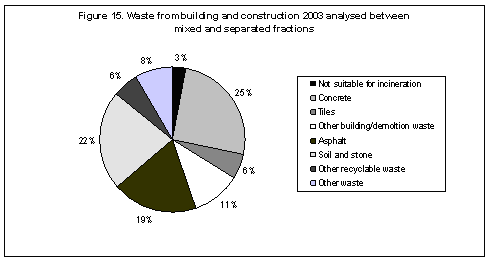
Source: ISAG reports 2003. The key is listed clockwise beginning at “12 o'clock”. A large part of the waste from the building and construction sector is reprocessed at mobile crushing plants which are used for different assignments at different locations throughout Denmark. The owner of the mobile crushing plant is responsible for the ISAG reports to the Danish EPA, but sometimes the entrepreneur also reports the waste. The Danish EPA is very much aware of this possible source of double reporting, and great efforts are being made, in co-operation with the providers of the reports, to ensure quality control and avoid double reporting. 5.5 Residues from coal-fired power plantsThe generation of residues at coal-fired power plants varies from one year to the next due to variations in Danish imports/exports of electricity to and from Sweden and Norway. Imports/exports of electricity to and from Sweden and Norway depend largely on precipitation in these countries - if there is much precipitation, much electricity is generated from hydropower in Sweden and Norway, and Danish exports will be correspondingly lower. For example, in 1996 exports of power were particularly high, which is reflected in amounts of residues in this year, cf. Figure 16. In 2000, there was high precipitation in Sweden, which resulted in so much cheap hydroelectricity on the market that power stations in both Denmark and Norway had to cease operations temporarily. Amounts of residues have decreased steadily since 1996, but show an increase from 2002 to 2003. The decrease is mainly explained by the last 10 years' strategy to phase out coal, so that in the long term coal will be replaced by natural gas and renewable energy sources, including bio-fuels. Energy statistics [26] reflect that an increasingly smaller share of electricity generation is based on coal. Also in future, the strategy to phase out coal will result in a decrease in residues from coal-based energy generation, whereas there will be an increase in fly ash and bottom ash from bio-fuels. Residues from coal-fired power plants amounted to around 1,473,000 tonnes in 2003, which is an increase of 20 per cent from 2002. As Figure 16 shows, 96 per cent of residues was recycled and 4 per cent was landfilled. The increase is due to the fact that, in net terms, in 2003 Denmark exported 3 times more of electricity than in 2002. [27] 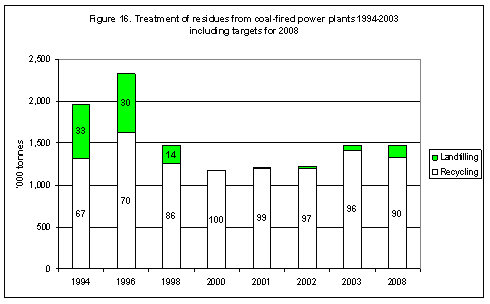
Source: same as Tables 1 and 2. Note that arisings in 2008 have been set to correspond to arisings in 2003. The figures are not projections of developments in waste arisings. 
Source: same as Tables 1 and 2. Note that arisings in 2008 have been set to correspond to arisings in 2003. The figure is not intended as a projection of developments in waste arisings In Table 30 recovery of residues in 2003 is stated in more detail. More than 90 per cent of residues is used as raw materials in industrial manufacture of, for example, cement, concrete and plaster board, whereas the remaining part is primarily used as backfilling, either in accordance with the provisions of Statutory Order no. 655 of 27 June 2001 from the Ministry of the Environment, or as backfilling with special approval under the Danish Environmental Protection Act. 5.6 Sludge from municipal treatment plantsSludge from municipal treatment plants amounted to 1,058,000 tonnes in 2003, which is an increase of 5 per cent, or 47,000 tonnes, from 2002. [28] The statement includes sludge exclusively, which means sand and screenings are excluded. As mentioned above, it was decided to state amounts of sludge for mineralisation with a dry matter content of 20 per cent, so that sludge for mineralisation would be stated with the same dry matter content as other sludge. If stated in wet weight, sludge from municipal wastewater treatment plants would have amounted to about 1,370,000 tonnes in 2002, which is about 672,000 tonnes less than in 2001, corresponding to a fall of 33 per cent. Treatment of sludge from municipal wastewater treatment plants is shown in Figure 17. According to the Figure, 54 per cent of sludge is recycled, 42 per cent is incinerated, and 4 per cent is landfilled. The figures for recycling include 84,400 tonnes of sludge with a dry matter content of 20 per cent, corresponding to 1,125,334 tonnes in wet weight, which are being treated in long-term storage with the objective of further mineralisation. This amount has been included in the amounts for recycling because the sludge will be recycled after a number of years in storage. In the treatment in sludge mineralisation plants (long-term storage) sludge is reported with around 0.5 - 1 per cent dry matter content, whereas alternatives typically contain 20 per cent. 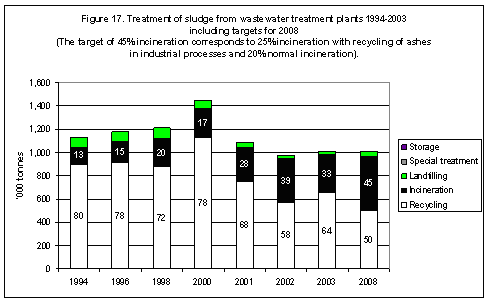
Source: same as Tables 1 and 2. Note that arisings in 2008 have been set to correspond to arisings in 2003. The figures are not projections of developments in waste arisings. The figure shown for 2003 is based on 2002 figures. The method of calculation of sludge for mineralisation has been changed with effect from 2001. The figures for recycling include 84,400 tonnes of sludge with a dry matter content of 20 per cent, corresponding to 1,125,334 tonnes when stated in wet weight. Long-term storage and incineration amounts include 139,555 tonnes for other uses (Carbogrit and production of concrete). 
Source: same as Tables 1 and 2. Note that arisings in 2008 have been set to correspond to arisings in 2003. The figures are not projections of developments in waste arisings. The figure shown for 2003 is based on 2002 figures. Sewage sludge is mainly recovered as fertiliser on farmland. In recent years, the requirements regarding contents of certain organic and chemical substances in sludge applied to farmland have been made more strict. In the short term, the rate of recycling is therefore expected to decrease. In the long term, it is expected the general phase-out policy for xenobiotic substances will improve the quality of sludge further. Finally, it appears that alternative methods of sludge recovery are being discovered to an ever greater extent. After sludge incineration, the inorganic residue is recovered in the production of e.g. sand blasting agents, or cement. Sludge recovered by such alternative methods in 2002 [29] amounted to around 140,000 tonnes. In Figure 17, the around 222,000 tonnes have been included in incineration because it is recovery, not recycling. 5.7 Residues from waste incineration plantsFigure 18 shows amounts of residues (slag, fly ash, and flue-gas cleaning products) from waste incineration plants 1994 to 2003 in tonnes, including treatment option. Residues from waste incineration plants have not been included in calculations of total waste generation, since the waste would then be counted twice in the statistics. However, residues are a large waste fraction and to secure adequate capacity for their treatment, a calculation of amounts is required. By far the largest part of residues is recycled. The recycling rate was 97 per cent in 2003 which is 1 percentage point more than in 2002. Residues, however, are not recyclable when containing large quantities of heavy metals, which may leach into the environment and the groundwater. In such cases landfilling is required. 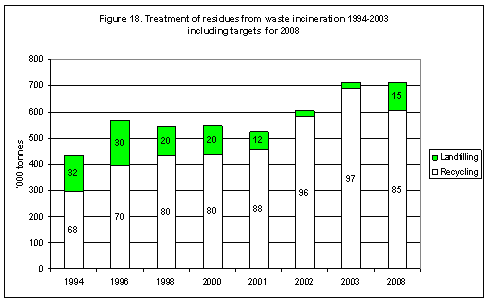
Source: See Tables 1 and 2. Note that arisings in 2008 have been set to correspond to arisings in 2003. The figures are not projections of developments in waste arisings. Note that Figure 18 is not comparable with Table 33 and Figure 19, because Figure 18 is exclusive of exported residues. 
Source: same as Tables 1 and 2. Note that arisings in 2008 have been set to correspond to arisings in 2003. The figures are not projections of developments in waste arisings. Contaminated fractions such as PVC, impregnated wood, and electric and electronic products, are not to be incinerated. This means that contents of heavy metals in slag will be reduced significantly. However, requirements for recycling of slag were tightened in 2000 to take account of the groundwater. The 2008 target of 85 per cent recycling has already been met. Table 33 shows the uses of residues from waste incineration. Naturally, amounts of residues depend on the amount of waste incinerated. Slag and flue-gas cleaning products typically comprise around 20 per cent and 5 per cent, respectively, of the waste amount led to incineration. Due to temporary storage at incineration plants amounts can, however, shift from one year to the next. Table 33 shows that residues from waste incineration amounted to around 733,000 tonnes in 2003. This is 105,000 tonnes more than in 2002. Out of the 733,000 tonnes of residues removed from waste incineration plants, around 245,000 tonnes were landfilled, while around 629,000 tonnes were recycled. This means that, in reality, the stored amounts of fly ash and flue-gas cleaning products have been reduced by about 141,000 tonnes. 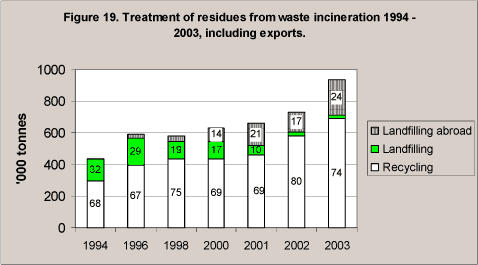
Source. ISAG reports and registrations under the EU regulation on shipments of waste. As is evident in Figure 19, the amount of residues exported for landfilling abroad has been increasing since 1996. The amount of residues exported for landfilling went up from 21,000 tonnes in 1996 to 226,000 tonnes in 2003. The main part of this amount has been excavated from landfills in Denmark, as evident in Figure 33. From 1996 to 2003, amounts of landfilled residues have increased by 27 per cent and the recycling rate has increased by 64 per cent. Footnotes [19] Exemption clause in Section 37(3), Danish Statutory Order on Waste (Statutory Order No. 619 of 27 June 2000) [20] The service sector covers the source: institutions, trade and offices. [21] Exemption clause in Section 37(3), Danish Statutory Order on Waste (Statutory Order No. 619 of 27 June 2000) [22] Statutory Order on Waste (Statutory Order no. 619 of 27 June 2000) [23] Statistical Ten-Year Review 2003. Statistics Denmark. [24] Enterprises subject to notification and approval, cf. Appendix 1 to Statutory Order no. 367 of 10 May 1992 on other activities than listed activities, with later amendments, and Appendix 1 to Statutory Order no. 646 of 29 June 2001 on approval of listed activities. [25] Circular No. 94 of 21 June 1995. [26] The latest Energy Statistics are found on www.ens.dk, the Danish Energy Authority's website. [27] Danish Energy Authority Monthly Electricity Statistics. [28] The statement for 2003 from municipal wastewater treatment plants of amounts of sludge applied to farmland and incineration of sludge at sludge incineration plants is not yet available due to a reorganisation of the electronic reporting system. For recycling and incineration, 2002 figures from the Danish EPA's sludge statistics have been used: “Sewage sludge from municipal and private treatment plants in 2002.” Environmental Review No. 5, 2004. For landfilling ISAG figures for 2003 have been used. [29] The statement for 2003 is not yet available.
|